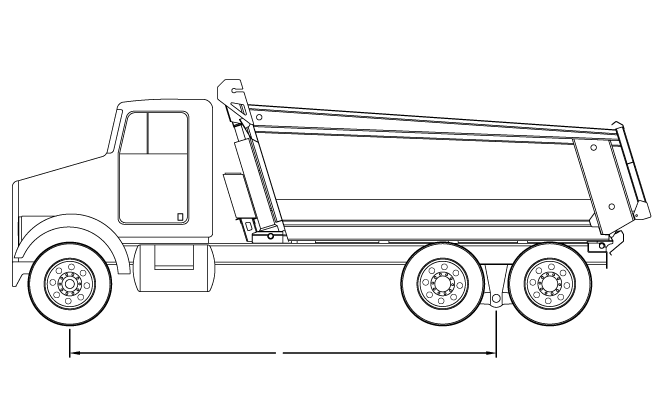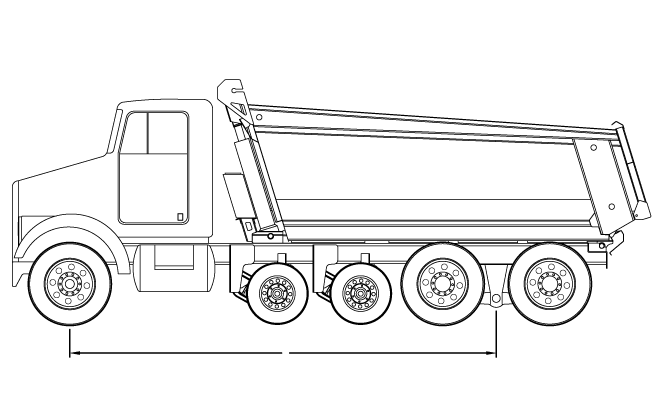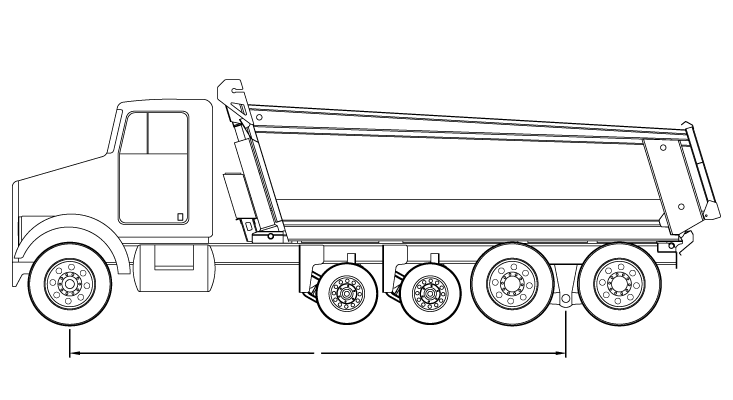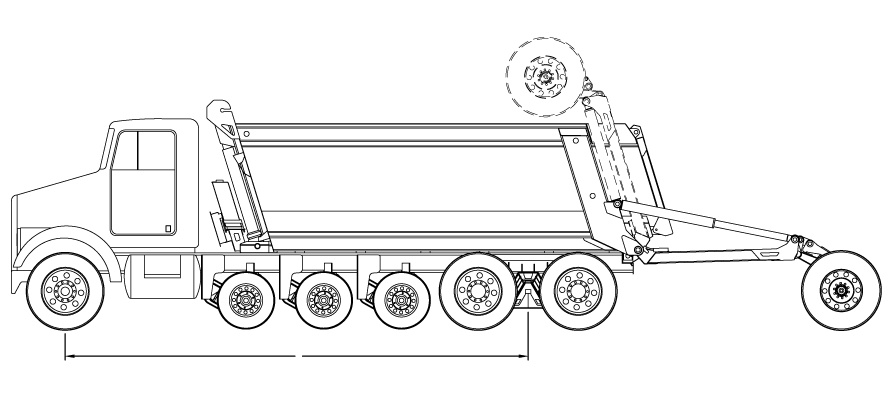
Select State
Federal Bridge Law
Federal regulations limit vehicle size and weight on federal highways. This includes all interstate highways across the country, as well as other federal roads designated within the National Highway System or National Network.
Vehicle Weight Limits
Federal weight limits of vehicles and axle loading limits are governed by the Federal Bridge Law (FBL), which has four primary rules:
- The maximum weight allowed on a single axle is 20,000 lbs
- The maximum total weight allowed on any two consecutive axles spaced eight or fewer feet apart (like tandem axles) is 34,000 lbs
- The maximum allowed Gross Vehicle Weight (GVW), or the maximum allowed total weight on any group of consecutive axles on a vehicle, is determined by the Federal Bridge Formula (FBF).
- The maximum Gross Vehicle Weight (GVW) on Interstate highways is 80,000 lbs, even when the result of the formula is greater.
The Federal Bridge Formula (FBF)
W = [ ( (LN) / (N - 1) ) + 12N + 36 ]
- W = the maximum allowed total weight in pounds for all axles in the group (rounded to the nearest 500 lbs, and rounding down when right in the middle - i.e. 62,250 lbs rounds to 62,000, while 62,300 lbs rounds to 62,500)
- L = the length or distance in feet (rounded to the nearest foot) from the center of the forward-most axle in the group to the center of the rear-most axle in the group
- N = the total number of axles in the group
Essentially, the Federal Bridge Formula allows a vehicle to weigh more when there are more axles and/or there is more distance to spread its weight out.
The Federal Bridge Table
For convenience, the Federal Highway Administration published the Federal Bridge Table, which allows one to quickly lookup the federal maximum gross weight on a vehicle or group of consecutive axles, based on number of axles and overall axle length:Federal Bridge Law Examples




Vehicle Size Limits
Federal regulations limit vehicle size as follows:
- Width: The maximum width of a vehicle is limited to 102 inches
- Length: For straight trucks*, vehicle length is not federally regulated. This regulation is left to the individual states.
- Height: Vehicle height is not federally regulated. This regulation is left to the individual states.
Michigan Bridge Laws
Notice: The Federal Bridge Law (FBL) and Federal Bridge Formula (FBF) apply to all interstate and federal highways across the nation, and many states have adopted them state-wide. We'll often refer to these federal regulations as simply "FBL" or "FBF". Expand the Federal Bridge Law panel above for detailed information on the federal regulations.
Michigan Vehicle Weight Limits
Quick Summary / Synopsis for Dump Trucks
Michigan has adopted the FBF state-wide, but also allows older grandfathered state law limits for trucks exceeding 80,000 lbs gross weight. These grandfathered limits have lower weight limits for single axles and tandem axles: A typical straight dump truck would be limited to 18k on the front axle, 32k on the tandem drive axles, and then 13k on each auxiliary axle.
So in theory, a Quint with 3 auxiliary axles could weigh up to 89,000 lbs. However, in reality it isn't possible for a typical straight dump truck like a Quint to distribute enough weight to the forward axles for this to be possible (the tandem drive axles would inevitably greatly exceed the 32k limit, while the steer axle and forward pusher axle would be under-loaded), and so a typical Quint wouldn't be able to weigh over 64,000 lbs due to those axle limits and weight distribution. This is why combination trailers (pup trailers and transfer trailers) are so popular in Michigan.
Michigan Truck Operator Map (with Vehicle Weight Limits)
Note: The weight limits stated here don't account for the seasonal restrictions. The link above shows the breakdown of the vehicle weight limits in MI with the seasonal restrictions, as well as the designated highways (the green and gold roads) where vehicles are allowed 102" in width (96" width limit on non-designated highways).
Recommendations
In Michigan, a combination rig (pup or transfer trailer) will deliver the highest GVW and per-trip payload -- 40+ ton payloads are possible with combinations (or "trains" as they're commonly called in MI). However, a 7-axle Super Dump can carry 32 tons on single straight truck, which is actually more productive on short-to-mid-range jobs.
One unique characteristic of the Super Dump is how the Strong Arm trailing axle distributes significant weight from the tandem drive axles to the front axle(s). With this weight re-distribution capability, and 13k to 14k lbs on the trailing axle, a 7-axle Super Dump can (legally and practically) weigh up to 95,000 lbs in Michigan - which would mean payloads of 32 Tons.
When you account for turnaround time -- all the extra time spent in transit and at the dump sites with pups and transfers -- Super Dumps will typically be able to make 50% more trips in a work day.
So if a pup/transfer/train can make 4 trips hauling 44 tons each trip, it would haul 176 tons that day. While a Super Dump would make 6 trips hauling 32 tons each trip, which would be 192 tons hauled that day.
Examples for Michigan

Michigan Vehicle Size Limits
Michigan has the following restrictions on vehicle size*:
- Width: The maximum width of a vehicle is 96 inches
- Length: The maximum length of a straight truck is 40 feet
- Height: The maximum height of a vehicle is 13 feet 6 inches
DISCLAIMER:
We try to stay accurate and up-to-date with any changes to the state weight laws, specifically as they pertain to dump trucks, utilizing resources from the Federal Highway Association, popular national vehicle weight guides and manuals, and the individual states' government websites and their official statutes. The weight laws within individual states can be complicated, however, especially when special permits, federal law grandfather rights, seasonal stipulations, and so forth are thrown into the mix. Our purpose here is to present each state's weight laws as they pertain to the typical dump truck, doing typical dump truck work, in the most common dump truck circumstances. If you have some special circumstance or scenario with your truck, we encourage you to visit your state's government website directly, or call your state Department of Transportation. Additionally, if you've discovered an error with our presentation of your state's laws, please let us know via our Contact Us Form and we'll make any necessary corrections immediately.

